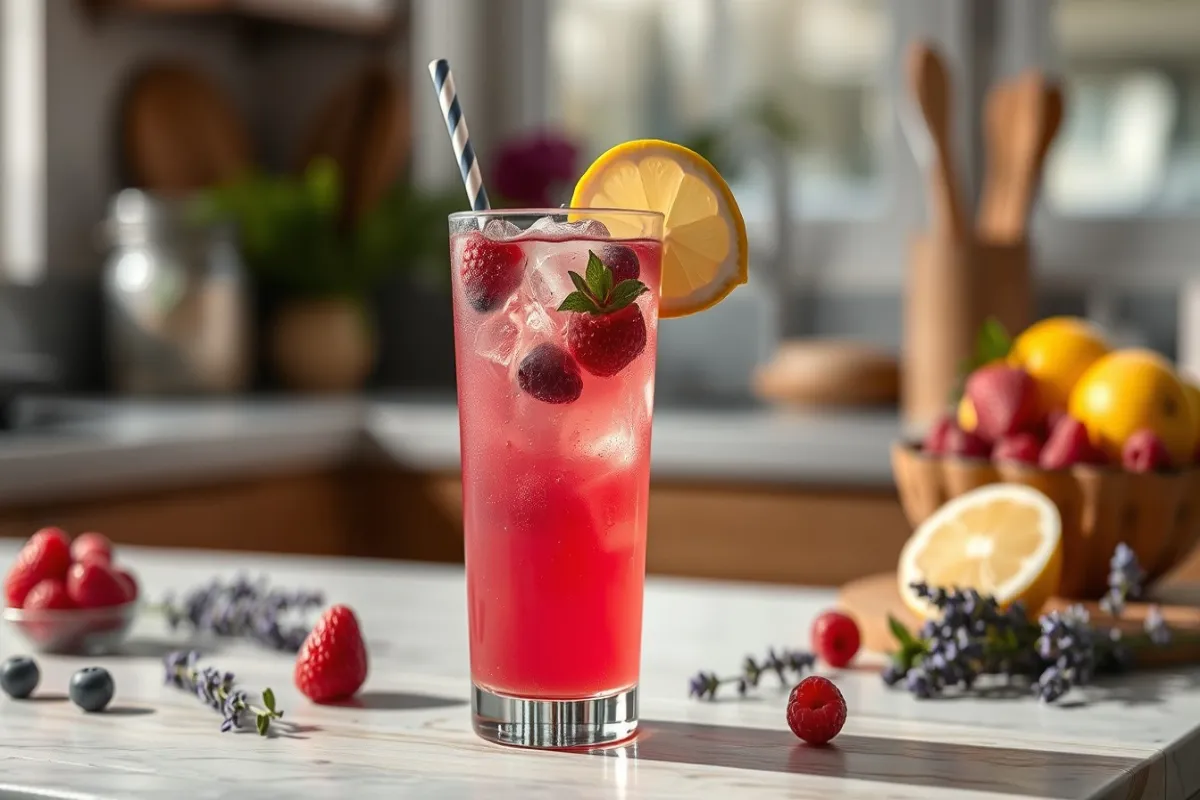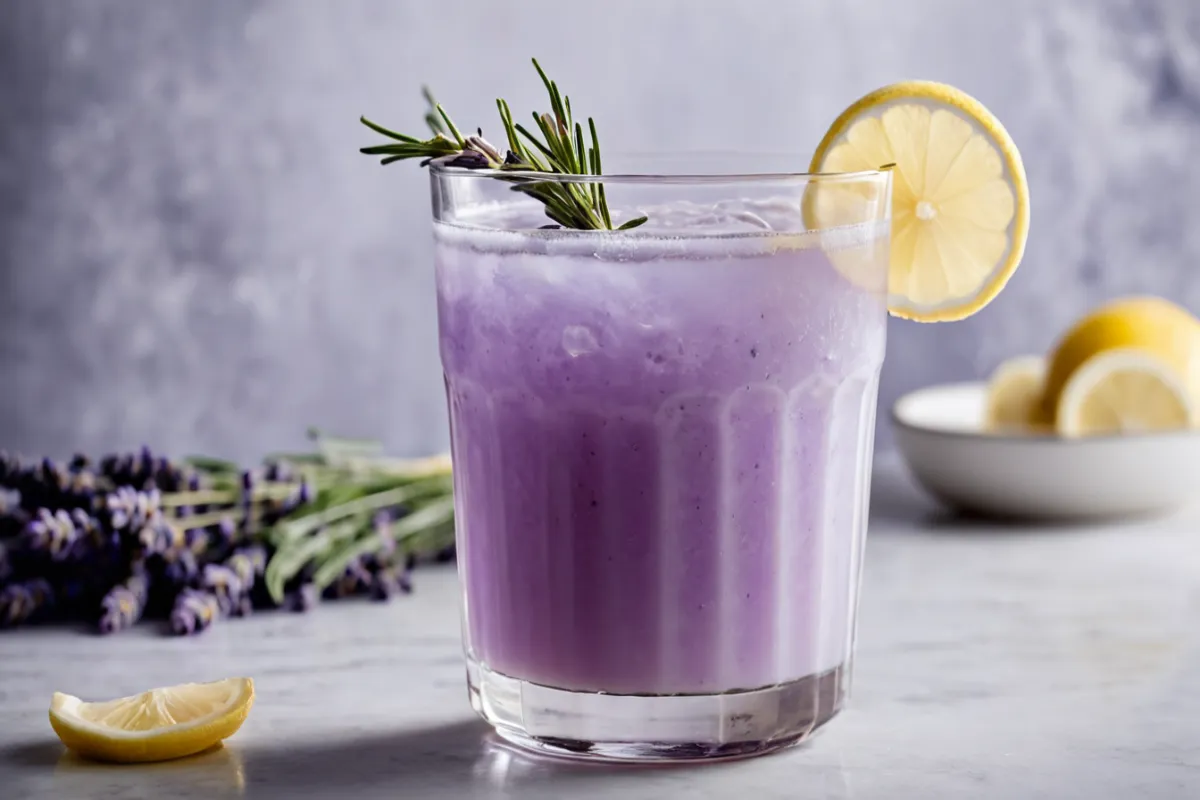Table of Contents
Lavender Lemonade Recipe: A Refreshing Drink with a Floral Twist
Introduction to Lavender Lemonade
Lavender lemonade isn’t just a refreshing beverage; it’s an experience for the senses. The calming scent of lavender combined with the tangy zest of lemon creates a drink that’s as pleasing to the nose as it is to the taste buds. But lavender lemonade is more than just a delicious treat; it’s also a drink with deep roots and a host of health benefits. In this article, we’ll explore the origins of lavender lemonade, the health perks it offers, and how you can make this delightful drink at home.
Lavender, with its vibrant purple flowers and soothing aroma, has been used for centuries in various cultures for both medicinal and culinary purposes. When combined with the bright, citrusy flavor of lemon, the result is a drink that’s perfect for any occasion—from a lazy afternoon in the garden to a festive summer gathering. And with the growing interest in natural and holistic remedies, lavender lemonade has gained popularity as a delicious way to enjoy the benefits of this powerful herb.
The Origins of Lavender Lemonade
Lavender’s history stretches back thousands of years. Ancient Egyptians used lavender in their mummification processes, while the Romans added it to their baths and cooking for its fragrant properties. In medieval times, lavender was scattered on the floors of castles and homes to ward off pests and maintain cleanliness. But how did lavender make its way into our drinks?
The concept of lemonade itself has ancient origins. It’s believed that lemons, native to Asia, were brought to Europe by Arab traders. By the 16th century, lemonade became a popular beverage in France, known for its refreshing qualities. Lavender lemonade, however, is a more recent creation, likely born out of the desire to incorporate the calming properties of lavender into everyday life. The combination of lavender’s floral notes with the tartness of lemon creates a uniquely balanced drink that’s both refreshing and soothing.
Lavender lemonade likely emerged as part of the broader trend of infusing beverages with herbs and flowers. As people began to explore the culinary uses of lavender, they discovered that its subtle floral flavor pairs beautifully with the acidity of lemon. Over time, this combination became a favorite among those seeking a refreshing and aromatic drink.
Health Benefits of Lavender Lemonade
Lavender’s Health Benefits
Lavender is well-known for its ability to soothe the mind and body. It’s often used in aromatherapy to reduce stress and anxiety, promote restful sleep, and relieve headaches. But lavender’s benefits extend beyond its calming scent. When consumed, lavender can help reduce inflammation, improve digestion, and even support heart health.
Recent studies have shown that lavender can be effective in reducing anxiety and improving mood. It’s also known to have anti-inflammatory properties, which can help reduce pain and swelling in the body. Additionally, lavender has antimicrobial properties, making it a natural choice for boosting the immune system.
Ingesting lavender, particularly in a drink like lavender lemonade, allows you to enjoy these benefits in a more direct and enjoyable way. The herb’s compounds work to calm the nervous system, reduce tension, and promote a sense of well-being, making it an excellent choice for those dealing with stress or anxiety.
Lemon’s Health Benefits
Lemons are a powerhouse of health benefits. They’re packed with vitamin C, which is essential for a strong immune system. Vitamin C is also a potent antioxidant, helping to protect the body against free radicals and reduce inflammation. Beyond that, lemons aid in digestion, support heart health, and may even help in weight management.
The high vitamin C content in lemons supports the production of collagen, which is vital for healthy skin, blood vessels, and bones. Lemons also contain pectin, a type of fiber that can help improve digestion and promote feelings of fullness. The citric acid in lemons aids in the absorption of iron, which is important for maintaining healthy blood cells.
Drinking lemon-based beverages like lavender lemonade can help keep your digestive system running smoothly and provide a refreshing way to stay hydrated. The acidity of lemons also promotes saliva production, which aids in digestion and helps cleanse the mouth, preventing bad breath.
Combined Health Benefits in Lavender Lemonade
When you combine the health benefits of lavender and lemon, you get a drink that’s not only refreshing but also incredibly nourishing. Lavender lemonade offers a host of benefits, from reducing stress and anxiety to boosting the immune system and improving digestion.
Lavender lemonade can be particularly beneficial for those who experience anxiety or have trouble sleeping. The calming effects of lavender combined with the hydrating and detoxifying properties of lemon create a drink that can help you unwind and relax. It’s a natural alternative to sugary sodas or artificially flavored drinks, offering a healthier way to quench your thirst.
Moreover, the antioxidants in both lavender and lemon help combat oxidative stress, which can lead to chronic diseases. Regular consumption of lavender lemonade can support overall health, making it a great addition to your daily routine.
Ingredients and Preparation
Essential Ingredients for Lavender Lemonade
To make the perfect lavender lemonade, you’ll need a few simple ingredients:
- Lavender: Fresh or dried culinary lavender is essential for this recipe. Avoid ornamental lavender, as it may contain chemicals not suitable for consumption.
- Lemons: Fresh, juicy lemons are key to achieving the best flavor. You’ll need enough to make about 1 cup of fresh lemon juice.
- Sweetener: You can use sugar, honey, agave, or a sugar-free alternative like stevia, depending on your preference.
- Water: This will be used to make both the lavender syrup and the lemonade base.
- Ice (optional): Ice cubes are optional but recommended for serving.

Each of these ingredients plays a crucial role in the final flavor of your lavender lemonade, so be sure to use the highest quality ingredients you can find.
Choosing the Best Lavender for Your Lemonade
Not all lavender is suitable for culinary use. When making lavender lemonade, it’s important to use culinary-grade lavender, which is specifically grown for cooking and consumption. Culinary lavender is less pungent than ornamental varieties and has a sweeter, more delicate flavor that works well in beverages.
Culinary lavender can be found at health food stores, specialty markets, or online. When selecting your lavender, look for flowers that are vibrant in color and have a strong, pleasant aroma. Store your lavender in an airtight container away from direct sunlight to preserve its flavor and potency.
If you have access to fresh lavender, you can use it in your lemonade, but be sure to wash it thoroughly before use. Fresh lavender tends to have a more intense flavor than dried, so you may need to adjust the amount used in the recipe.
Sweeteners and Their Impact on Taste
The type of sweetener you choose can significantly impact the flavor of your lavender lemonade. Here’s a breakdown of popular options:
- Sugar: Traditional granulated sugar provides a neutral sweetness that allows the flavors of lavender and lemon to shine. It’s the most common sweetener used in lemonade.
- Honey: Honey adds a floral note that complements the lavender beautifully. It also has additional health benefits, such as antibacterial properties and antioxidants.
- Agave: Agave syrup is a natural sweetener that has a milder flavor than honey. It’s a good option for those looking to reduce their sugar intake, as it has a lower glycemic index.
- Stevia: For a sugar-free option, stevia is a great choice. It’s a natural sweetener derived from the stevia plant and doesn’t add any calories to your drink.
Each sweetener will affect the final taste of your lavender lemonade, so choose one that best suits your preferences. You can also experiment with different sweeteners to find the perfect balance of flavors.
Step-by-Step Recipe for Lavender Lemonade
Preparation of Lavender Syrup
The first step in making lavender lemonade is to prepare the lavender syrup. This syrup will serve as the base of your drink, infusing it with the floral essence of lavender. Here’s how to make it:
- Ingredients:
- 1 cup of water
- 1 cup of sugar (or honey)
- 2 tablespoons of dried culinary lavender
- Instructions:
- In a small saucepan, combine the water and sugar (or honey). Heat over medium heat, stirring until the sugar is completely dissolved.
- Add the dried lavender to the saucepan and bring the mixture to a boil.
- Reduce the heat and let the mixture simmer for 5-10 minutes, allowing the lavender to infuse the syrup.
- Remove the saucepan from the heat and let the syrup steep for about 30 minutes.
- Strain the syrup through a fine-mesh sieve to remove the lavender flowers, then set the syrup aside to cool.
This lavender syrup can be made ahead of time and stored in the refrigerator for up to a week. It’s also a versatile ingredient that can be used in other recipes, such as mocktails, desserts, or even iced tea.
Making the Lemonade Base
While your lavender syrup is cooling, you can start preparing the lemonade base. Fresh lemon juice is essential for the best flavor, so avoid using bottled lemon juice if possible. Here’s how to make the lemonade base:
- Ingredients:
- 1 cup of freshly squeezed lemon juice (about 4-6 lemons)
- 4 cups of cold water
- Instructions:
- Juice the lemons until you have about 1 cup of fresh lemon juice. Be sure to remove any seeds from the juice.
- In a large pitcher, combine the lemon juice with 4 cups of cold water. Stir well to mix.
The lemonade base should be tart but not overly sour. You can adjust the amount of lemon juice or water to achieve your desired level of tartness.
Mixing Lavender Syrup with Lemonade Base
Once your lavender syrup has cooled and your lemonade base is ready, it’s time to combine the two. This is where the magic happens, as the floral lavender and zesty lemon come together to create a uniquely refreshing drink.
- Instructions:
- Pour the lavender syrup into the lemonade base in the pitcher.
- Stir the mixture thoroughly to ensure the syrup is evenly distributed.
- Taste the lemonade and adjust the sweetness if needed by adding more syrup or a bit more water.
If you find the lemonade too tart, you can dilute it with more water or add extra syrup. For a more intense lavender flavor, you can steep additional lavender in the lemonade for a few hours before serving.
Serving Suggestions
Lavender lemonade is best served chilled, making it the perfect drink for a hot summer day. Here are some serving suggestions to make your lavender lemonade even more enjoyable:
- Over Ice: Serve the lemonade over ice cubes in a tall glass. For an extra touch of elegance, use lavender-infused ice cubes by freezing lavender flowers in the ice trays.
- Garnish: Garnish each glass with a sprig of fresh lavender and a slice of lemon. This not only adds visual appeal but also enhances the drink’s aroma.
- Sparkling Version: For a sparkling version of lavender lemonade, add a splash of soda water or sparkling mineral water just before serving. This will give the drink a delightful fizz.
Variations and Customizations
Lavender lemonade is a versatile drink that can be customized in many ways. Here are some ideas to inspire your creativity:
Lavender Lemonade Variations
- Sparkling Lavender Lemonade: For a bubbly twist, add sparkling water to your lavender lemonade. This variation is particularly refreshing and perfect for special occasions. It’s also a great non-alcoholic alternative to champagne.
- Berry Lavender Lemonade: Mix in some fresh berries, such as raspberries or blueberries, for a fruity twist. The berries add a burst of color and flavor, making this variation a hit at summer parties.
- Herbal Lavender Lemonade: Enhance the floral notes of your lemonade by adding other herbs like rosemary, thyme, or mint. These herbs complement the lavender and add complexity to the flavor profile.

Lavender Lemonade for Different Occasions
This lemonade is suitable for a wide range of occasions. Here’s how you can customize it for different settings:
- Summer BBQs: Serve your lavender lemonade in mason jars with striped straws for a rustic, summery feel. Pair it with grilled dishes like grilled chicken wraps or corn on the cob for a complete summer meal.
- Brunch: For a light and refreshing brunch beverage, serve lavender lemonade alongside a cucumber tomato feta salad. The floral and citrusy notes of the lemonade complement the fresh, crisp flavors of the salad.
- Evening Relaxation: Enjoy a warm version of lavender lemonade in the evening as a calming, caffeine-free alternative to tea. Simply warm the lemonade and add a touch of honey for a soothing drink that helps you unwind before bed.
Culinary Uses and Pairings
Lavender lemonade isn’t just a drink—it can also be used in various culinary applications. Here are some ideas:
Culinary Uses of Lavender Lemonade
- Popsicles: Pour lavender lemonade into popsicle molds and freeze for a refreshing summer treat. You can add whole berries or slices of lemon to the molds for added flavor and visual appeal.
- Sorbet: Use lavender lemonade as a base for homemade sorbet. Simply churn the lemonade in an ice cream maker until it reaches a soft-serve consistency, then freeze until firm.
- Baking: Incorporate lavender lemonade into your baking by using it as a liquid ingredient in cakes, muffins, or scones. The lemonade adds a subtle floral and citrusy flavor to baked goods.
- Syrup: Reduce lavender lemonade over low heat until it thickens into a syrup. This syrup can be drizzled over pancakes, waffles, or ice cream for a delightful floral touch.
Pairing Lavender Lemonade with Food
Lavender lemonade pairs well with a variety of foods, making it a versatile beverage for meals and gatherings. Here are some pairing suggestions:
- Light Salads: The fresh and citrusy flavors of lavender lemonade complement light salads, such as a cucumber tomato feta salad. The drink’s floral notes balance the crisp, clean flavors of the vegetables.
- Grilled Chicken: Serve lavender lemonade with grilled chicken wraps for a delicious and balanced meal. The lemonade’s acidity cuts through the richness of the chicken, creating a harmonious pairing.
- Seafood: Lavender lemonade pairs beautifully with seafood dishes, such as grilled shrimp or salmon. The drink’s bright, citrusy notes enhance the natural sweetness of the seafood.
- Desserts: For a sweet finish, enjoy lavender lemonade with light, fruity desserts like lemon bars, berry tarts, or a simple fruit salad. The lemonade’s floral flavor complements the fresh, vibrant flavors of the desserts.
FAQs Section
Frequently Asked Questions About Lavender Lemonade
- Can I use dried lavender in lemonade? Yes, dried lavender is perfect for making lavender lemonade. Just make sure it’s culinary-grade lavender, as ornamental varieties may not be safe for consumption.
- What are the best sweeteners for lavender lemonade? The best sweeteners for lavender lemonade are sugar, honey, agave, or stevia. Each sweetener will affect the flavor differently, so choose one that suits your taste preferences.
- How long does lavender lemonade last? Lavender lemonade can be stored in the refrigerator for up to a week. Just make sure to keep it in a sealed container to maintain its freshness and prevent the flavors from fading.
- Can I make lavender lemonade without sugar? Absolutely! You can substitute sugar with honey, agave, or a sugar-free alternative like stevia. Adjust the amount of sweetener to your taste, and enjoy a healthier version of lavender lemonade.
- Is lavender safe to consume in beverages? Yes, culinary lavender is safe to consume and adds a wonderful flavor to beverages like lemonade. However, it’s important to use culinary-grade lavender to ensure safety and the best flavor.
- Can I use lavender essential oil in lemonade? It’s not recommended to use essential oils in food or drink unless they are specifically labeled as food-grade. Stick to using dried or fresh lavender instead, as essential oils can be too concentrated and may not be safe for ingestion.
Conclusion
Lavender lemonade is more than just a pretty drink; it’s a delicious and healthy beverage that’s easy to make at home. With its combination of floral lavender and tangy lemon, it’s sure to become a favorite in your household. Whether you enjoy it as a refreshing summer drink, a soothing evening beverage, or a creative mocktail, lavender lemonade is a versatile recipe worth trying.
In addition to its delightful flavor, lavender lemonade offers numerous health benefits, from reducing stress and anxiety to boosting your immune system. It’s a natural and enjoyable way to stay hydrated and promote overall wellness.
Now that you know how to make this delightful drink, why not give it a try? Experiment with different variations, share your creations with friends and family, and enjoy the calming, refreshing benefits of lavender lemonade. If you enjoyed this recipe, be sure to check out our other refreshing beverages like frozen lemonade recipes. Happy sipping!

